Complete Guide to Dabs: Cannabis Concentrates Types and Consumption Methods
Concentrated cannabis extracts have become one of the most popular ways to enjoy THC-rich cannabis products. However, getting started in the world of dabs can be a bit difficult for a few reasons. For one, every cannabis concentrate is made differently. They form different consistencies and textures under different conditions, and there are several ways to consume them. Here’s everything you need to know about cannabis concentrates – a complete guide to concentrated cannabis extracts for newbies.
Concentrates 101: How dabs are made
To start, it’s important to know that all cannabis concentrates are made by separating the THC-rich trichome heads from the cannabis plant in a process known as “extraction”. Cannabis concentrates usually fall into two different categories based on how they’re extracted from the cannabis plant or flowers: Solvent-based and solventless.
Solvent-based extractions are made by blasting the plant materials with chemical solvents like butane, CO2, or ethanol to strip all the plant materials away from the THC, leaving only the THC behind. Solvent-based extracts are then purged to remove all traces of the chemical solvents via evaporation. This leaves behind a solvent-free, solvent-based concentrate.
On the other hand, we have solventless extracts which do not use chemical solvents to isolate the THC. Solventless extracts are made with mechanical techniques that utilize heat, pressure, water filtration, or good ol’ fashioned grinding to separate the THC from the other plant materials.
Both extraction methods leave behind an extra-potent cannabis product and a good amount of terpenes with no unnecessary plant materials. Concentrates always contain anywhere from 70-99% THC and 3-25% terpenes. Many people prefer concentrates to ordinary cannabis flower because the effects are usually cleaner, easier to dose, longer-lasting, and better tasting. Ordinary cannabis flower only contains 10-25% THC on average, but it also contains a full spectrum of 80+ other cannabinoids like CBD, CBG, CBN and THC. Smoking flower destroys some terpenes and transforms some of the cannabinoids, so the effects are still full, but they don’t last as long as concentrates. The full spectrum of cannabinoids and terpenes also tends to make the high foggier and more difficult to accurately dose, which is another reason why many choose concentrates over flower.
Types of Cannabis Concentrates
Each cannabis concentrate is made with a solvent-based or solventless extraction method. Below, we’ll touch base on some of the most popular cannabis extracts and consistencies as well as their potency levels and how they’re made.
Shatter
Shatter is a solvent-based hydrocarbon extract (also known as a butane hash oil extract). It’s made by pressurizing butane and using the pressure to strip the THC from the plant material (usually trim) within a closed-loop system. The butane is then evaporated out of the shatter when it’s spread on a tray, leaving behind a hard translucent amber-colored product that can be broken into individual grams similar to broken glass.
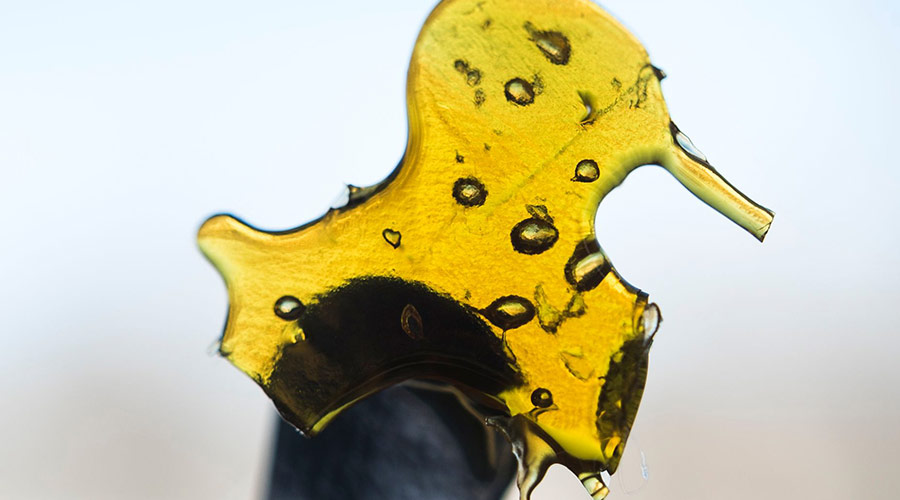
Wax
Crumble is wax with a crumbly texture that ranges in color from clear to orange. Like all wax, crumble is made using a solvent-based hydrocarbon (BHO) extraction, similar to shatter. It is a soft, opaque concentrate that comes in a number of different forms thanks to each strain’s unique properties that determine how it will react to heat and moisture during the initial purging process. It can be made by agitating shatter into a whipped or aerated consistency before it’s fully purged of butane and hardened to make things like crumble, sugar wax, or honeycomb. If the shatter is whipped and turns smooth, it may also be called budder, batter, or icing. Either way, if its soft and made using a BHO extraction, it’s wax.
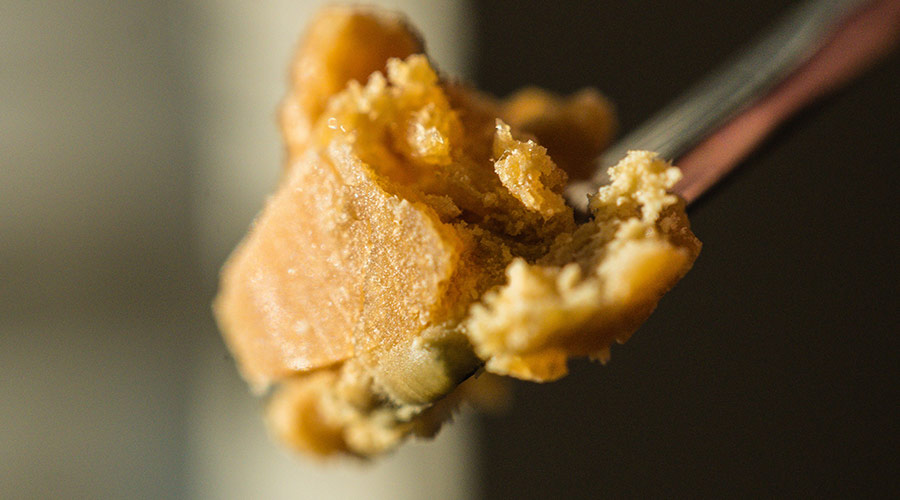
Rosin
Rosin is made using a solventless extraction method that involves pressing cannabis flowers with heat and pressure. The rosin method doesn’t require the use of any chemicals to concentrate the THC and remove the plant materials. It’s one of the most interesting concentrates since it preserves the most cannabinoids and terpenes by using heat and pressure to squeeze the other plant materials out. It comes in a variety of different colors and textures, ranging from milky white to orange. It goes by many other names, including sap, jam, solventless hash oil (SHO) and rosin batter.
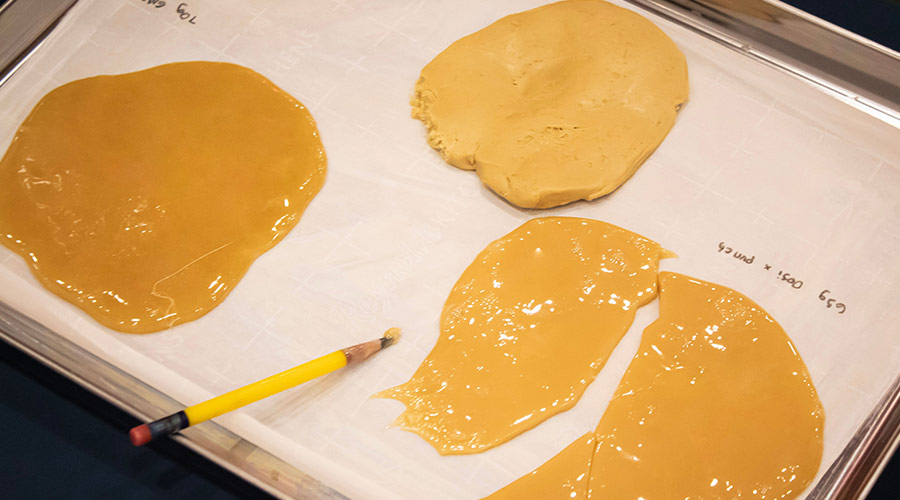
Live Resin
The term “live” refers to the plant materials used before the extraction. While most extracts use trim or small flowers, live concentrates are made by taking the trichomes from the still-living plants. Usually this involves harvesting the plant and getting it into a freezer to preserve the terpenes and cannabinoids and then processing it with the components still fresh and alive. This creates a more flavorful product since the terpenes remain undamaged and unaltered. Live products are usually made with a solvent-based hydrocarbon extraction method that utilizes heat and pressure and evaporates the solvent out, leaving behind a terpene sauce and a few small THCa “diamonds”. However, rosin can also be made using “live” plants using a solventless extraction method. Almost any type of extraction consistency can be made using live plants, including favorites like live resin, live sugar, live batter, live butter, and live rosin.
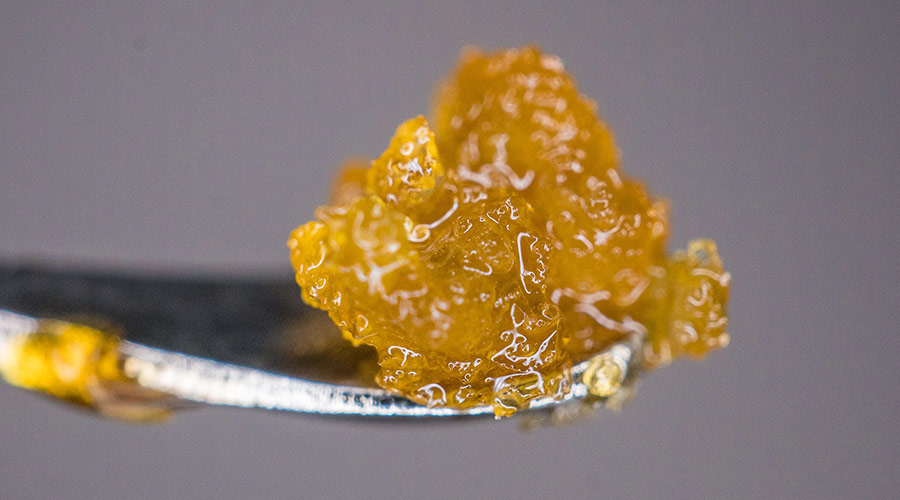
Distillate
Distillate is usually made from trim and uses a solvent-based CO2 extraction method to separate the THC from plant materials. This is the stuff you usually find in your edibles and topicals, since the extraction process removes everything from the plant except for the THC, including proteins, lipids, and terpenes. This leaves behind a flavorless product that is mostly clear and contains 90-100% THC. Some companies use distillate to make vape cartridges, too. However, these cartridges usually contain added synthetic terpenes to enhance the flavors.

Diamonds
THC diamonds are made using a solvent-based extraction method that involves a closed-loop system. They are made similarly to many other solvent-based products, with the difference being how the solvent is finally purged from the concentrated THC. They form in a crystalline structure similar to diamonds and are made primarily from THCa, which is non-psychoactive until it is dabbed. Diamonds can be formed both on their own and in a terpene-rich sauce. Each one is around 90% THCa.
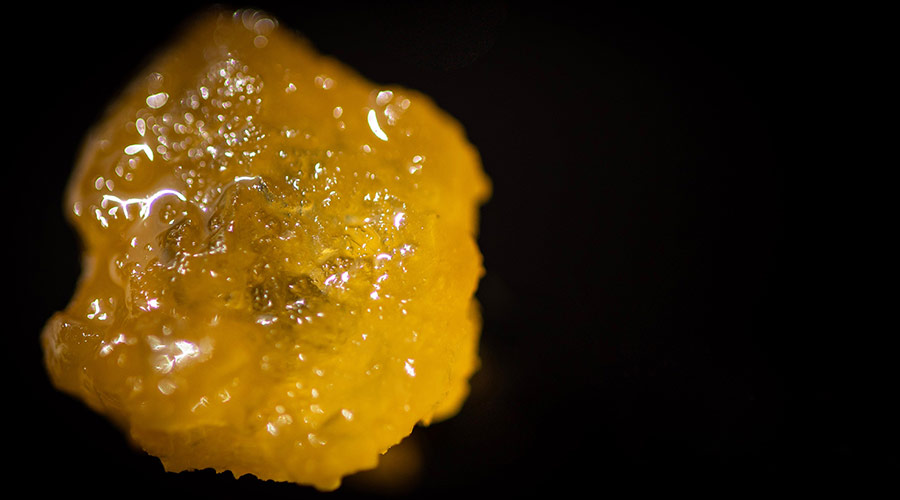
Sauce
Sauce is formed in the same way diamonds are, in a closed-loop, solvent-based hydrocarbon extraction process. Sauce is named after its consistency, which is thin and runny, similar to juice, honey, or marmalade. However, sauce is named for its terpene content as much as for its consistency. Many live concentrates and THCa diamonds are sold with Sauce. Sauce can also be sold on its own, as it can form small diamonds. Many sauces come with small diamonds and range in texture from thin and runny to thick and gritty.
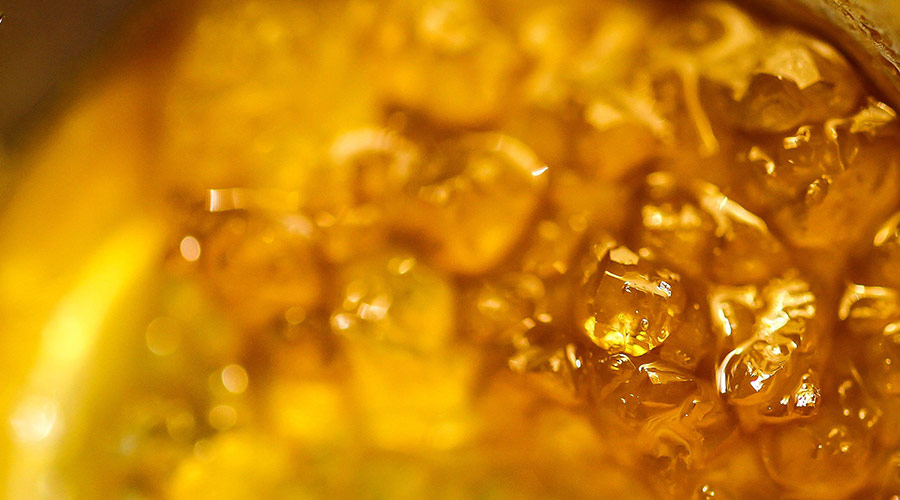
Hash Oil / Rick Simpson Oil
Hash oil, also known as Rick Simpson Oil, has a thick, syrupy consistency and is usually used in topicals, tinctures and edibles. Since it’s made using grain alcohol in a solvent-based extraction method, it usually isn’t a good choice for smoking as some residual solvents are often left behind. Some don’t, so it’s important to always check with your budtender before attempting to smoke a hash oil. Hash oils come in a variety of of flavors, potency levels, and with various different cannabinoids, but the consistency is always very viscous.
Kief / Dry-Sift
Kief is the precursor to dry-sift, and both are made without solvents. Kief is essentially the trichome heads that are mechanically separated from cannabis flowers using a grinder. Dry-sift is made with mesh screens in the same mechanical fashion, minus the grinding. It can be pressed into hash and even rosin by adding heat and pressure.
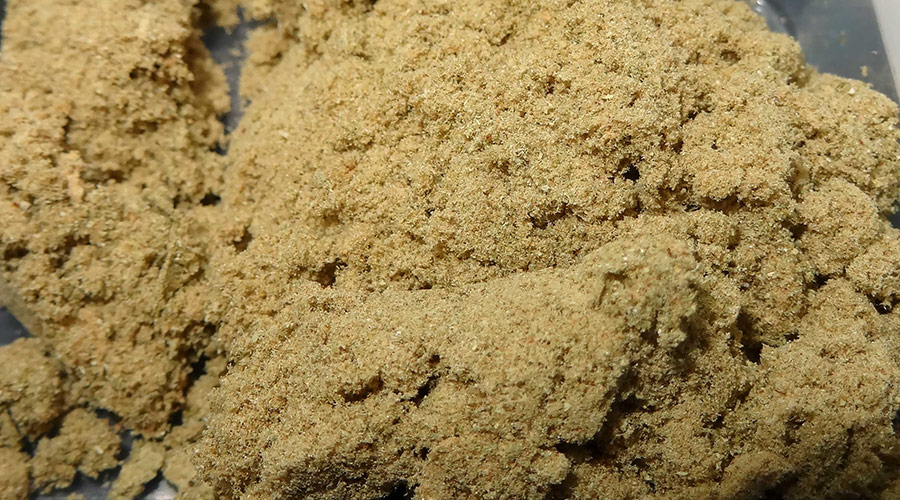
Bubble Hash
Bubble hash is made in a solventless extraction method that involves ice water or dry ice. The first step is agitating the flowers in ice water and then filtering them through fine-mesh bags or sieves. The final hash varies in texture from dry and dusty to oily. The best bubble hash is also called full melt or ice wax and can be pressed into rosin, smoked like hash, dabbed, or reserved for cannabis infusions, like edibles or topicals.
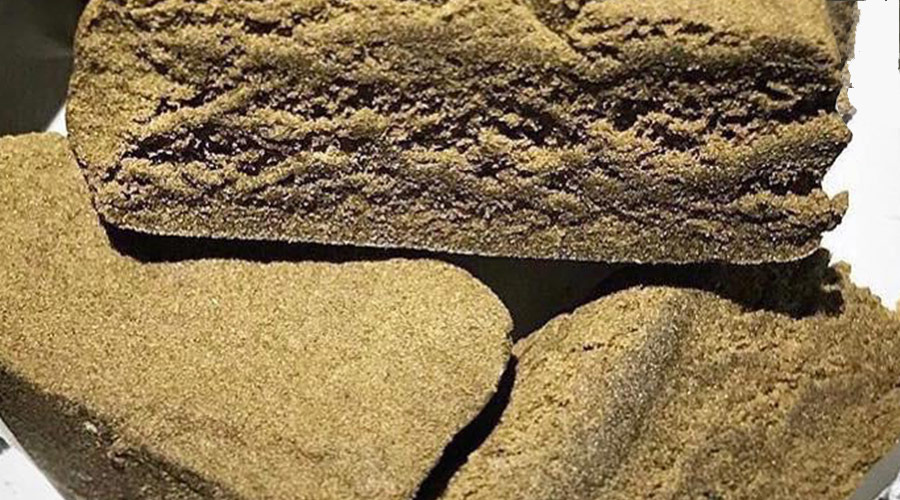
How to consume cannabis concentrates
There are four primary methods when it comes to consuming concentrated forms of cannabis. Each one has its own pros and cons, but here’s a quick rundown on how they all work.
1. Dabbing
When you think “concentrates”, dabbing is usually the first thing to come to mind. Dabbing involves heating up a quartz, titanium, or ceramic nail using a dab rig and a butane torch until it’s warm enough to activate the THC in the concentrate. You can dab most concentrates, including shatter, wax, rosin, sauce, diamonds, and live products by dropping them into the warm nail and inhaling them. If you’re trying to dab without a rig, check out the below options.
2. Vaping
Vaping is another way to consume cannabis concentrates. While you can load up most dabbable concentrates into portable vaporizers, you can also buy distillate or CO2-extracted vape cartridges at most dispensaries. Vaping uses a battery to heat up the concentrate in the chamber, allowing you to toke on the go without carting around concentrates.
3. Ingestion (via edibles)
Many concentrates, like distillate and hash oil, are used to make edibles. If you buy edibles from a dispensary, they’re usually made with distillate, CO2 oil, or hash oil. That’s just one way to get concentrated cannabis into your body without having to physically smoke it. Many other concentrates are ingestible too, including tinctures, capsules, and other oils. Learn more about making edibles with dabs here.
4. Topping bowls, joints, and blunts
Concentrates like wax, shatter, kief, dry sift, and bubble hash can be used alongside ordinary cannabis flowers to add more flavors and potency. You can roll shatter and wax into blunts and joints to create an uber-potent, slow-burning sesh, or you can dip joints in hash oil and kief. You can also top bowls with wax, shatter and kief. Each bowl topper makes the bowl last longer, taste better, and feel more potent.
All in all, there are a lot of cannabis concentrates to keep track of. If you’ve ever wondered what concentrates are or how they’re made, this outline covers everything you need to know. Be sure to share this handy guide with others if you found it helpful.




















